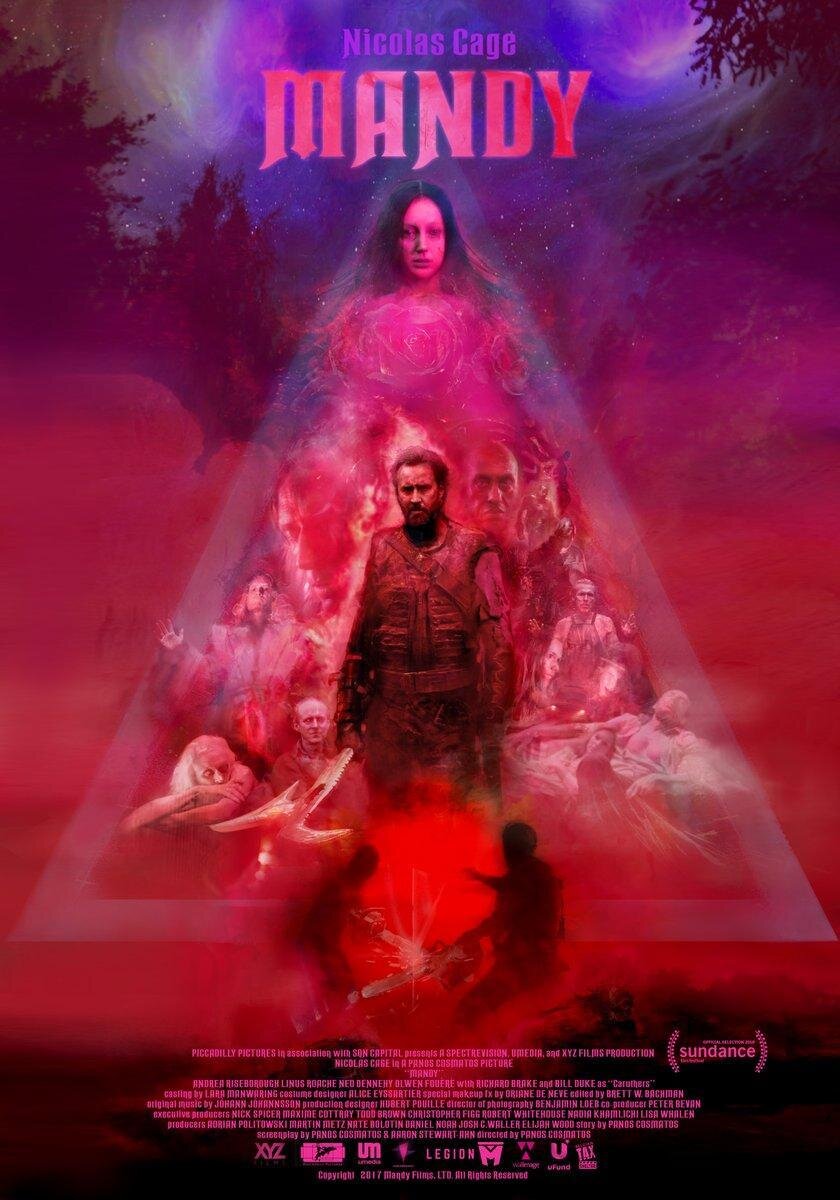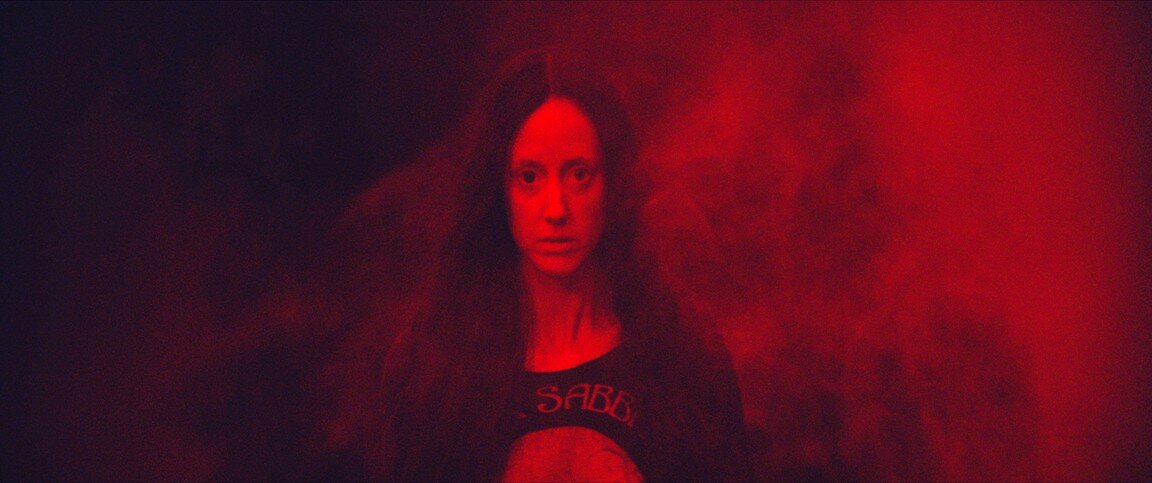Mandy (2018) film review - a technicolour nightmare
★★★☆☆
‘Mandy’ follows the lives of couple Red Miller and Mandy Bloom, who are very much happy and in love until their tranquil existence is thwarted by a vicious cult.
Director: Panos Cosmatos. Starring: Nicolas Cage, Andrea Riseborough, Linus Roache, Bill Duke. 18 cert, 121 min.
After the vibrant obscurity of ‘Beyond the Black Rainbow,’ director Panos Cosmatos returned to give us the action-packed horror thriller ‘Mandy.’ Kaleidoscopic and visually stunning, ‘Mandy’ follows the lives of couple Red Miller and Mandy Bloom, who are very much happy and in love until their tranquil existence is thwarted by a vicious cult. Set in 1983, the same year as the director's 2010 film ‘Beyond the Black Rainbow,’ 'Mandy’ thoroughly commits itself to delivering a candy-coloured, 80s hellscape. And it does so successfully. Bloody, shocking, and enticingly vivid, this film takes its viewer on a visual and auditory journey through what could very well be a nightmarish LSD trip.
‘Mandy’ (2018) film poster artwork
Cults and drugs in ‘Mandy’
Mandy, played by Andrea Riseborough, very much fulfils the bohemian, almost fairylike aesthetic that cult leader Jeremiah Sand desires. Struck by her beauty when he chances upon her in the isolated woodland setting the characters of ‘Mandy’ inhabit, from this point on her Arcadian life with husband Red mutates into something evil. Red, who is played by Nicolas Cage, is transported into a world filled with monsters, hallucinatory experiences, and brutal acts of violence. Though 'Mandy’ has a somewhat slow start, Cosmatos soon catapults you into action with a story that reads as a tension filled slasher film on acid.
Compared to ‘Beyond the Black Rainbow,’ ‘Mandy’ is incredibly clear-cut. However, it still manages to retain the otherworldly cinematography characteristic of Cosmatos. Though both films deal with the concept of cults, 'Mandy’ depicts a twisted hippie group that appears to oscillate between religious fanaticism, and worship of a darker force one would associate more with Hell than with Heaven. This is shown by the Black Skull bikers, a demonic group of subhuman creatures summoned by cult leader Jeremiah Sand in order to kidnap Mandy. Claiming the title ‘Children of the New Dawn,’ Jeremiah’s movement is reminiscent of a more traditional idea of what a cult is. Comparable more to the infamous Manson family than the futuristic sect in ‘Beyond the Black Rainbow,’ the cult in ‘Mandy’ is formed under the figure of a failed musician, twisted and warped through years of psychedelic abuse.
A comparison to Cosmatos’ 2010 film ‘Beyond the Black Rainbow’
Warning: contains spoilers. What I found interesting about ‘Mandy’ was its use of a sacrificial female figure as a kind of transportation into another world. This is because it is very similar to ‘Beyond the Black Rainbow,’ where scientist Dr Nyle keeps a young girl Elena, who possesses psychic abilities, prisoner in the Arboria Institute. Presented under the guise of advancing the human species to a perpetual state of happiness, the Arboria Institute is a cult like organisation that uses drugs as a portal to a state of visionary insanity. Sound familiar? After Jeremiah, played by Linus Roache, burns Mandy alive for her defiance, Red finds himself transported to a similar form of madness. He experiences vivid dreams in which he sees Mandy suffering, martyr-like in her tragic beauty. Interestingly, Cosmatos chooses to portray these scenes in an animated style. Red is subsequently spurred into embarking on a brutal killing spree of the Black Skulls and Children of the New Dawn, during which he is heavily influenced by the drugs he takes from them.
‘Mandy’ seems inspired by 80s fantasy horror and the work of director David Lynch just as much as ‘Beyond the Black Rainbow.’ In Cosmatos’ most 2018 film, Brother Swan shows Red a blade that he describes to be ‘the tainted blade of the Pale Night, straight from the Abyssal Lair.’ As well as being a reference to Dungeons and Dragons, the blade is evocative of ‘The Devil’s Tear-Drop' that Dr Nyle dons in ‘Beyond the Black Rainbow.’ Both films can also be viewed as parables illustrating how humans wandering too far outside of nature can breed something depraved. In ‘Beyond the Black Rainbow,’ Dr Nyle is corrupted by his spiritual journey into darkness much like Jeremiah’s followers appear to have been in ‘Mandy.’
The ending of ‘Mandy’ explained
Having successfully destroyed the Black Skull bikers, Red seeks out the Children of the New Dawn. Finding them at a sloppily constructed church nearby, what follows is essentially a montage of increasingly creative killings that feel like they belong in an action film rather than a horror. It reminded me, visually, of a more intense rendition of Joe Begos’ 2019 film ‘Bliss.’ A technicolour nightmare, the imagery in ‘Mandy’ indulges in an excessively red-hued style that acts as a backdrop to the ruthless mass killing that takes place. My one complaint about this film was that the second half is considerably disappointing after its promising set-up. It is also nowhere near as intelligent as ‘Beyond the Black Rainbow’ in the way it explores its themes. Nonetheless, ‘Mandy’ is still a wholly entertaining watch. Displaying the hypocrisy of a man who portrays himself as a God, the film culminates in Red gruesomely killing Jeremiah with his bare hands before setting the satanic church alight. ‘I am your God now,’ he says.
Should you watch this before you die?
Overall, ‘Mandy’ is a heavily stylised horror film that acts both as a standalone revenge slasher and an intriguing companion piece to Cosmatos’ 2010 ‘Beyond the Black Rainbow.’ Though certainly not for everyone, it explores a simple premise with a vibrant 80s aesthetic and does so in an oddly enthralling manner. Nicolas Cage gives an outstanding performance as a forsaken husband driven by a desire for vengeance, and the antagonistic figure of Jeremiah Sand is one of my favourite movie villains to date. For fans of cult films and the increasingly popular experimental sub-genre of horror, ‘Mandy’ is a must watch.



